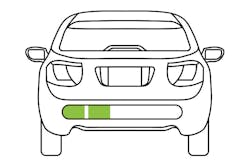When Craig Van Batenburg started his tiny shop in 1977 only working on Hondas, everyone called him crazy. When he moved to working on hybrid cars, everyone called him crazy.
His response to those people now?
“I won.”
While he’s no longer a shop owner, Van Batenburg has continued to spread his electric vehicle (EV) wisdom as the founder and CEO of the Automotive Career Development Center (ACDC), which trains technicians on hybrid/EV repairs. And while he mainly works with mechanical repair shops, he says the rising popularity of EVs should be of concern to collision repair shops, which largely don’t understand how to properly handle EV batteries.
According to the International Energy Agency, there were 2 million EVs on the road as of 2016. And with automakers such as Volvo going fully electric by 2019 and Ford investing $11 billion in EV technology, that number is only increasing.
As the EV market continues to rise, it’s important for collision repair shop owners to understand and adapt in the necessary areas. Van Batenburg gave FenderBender an inside look at the main areas of concern.
Why are collision repair shops so unprepared to handle EV batteries?
Getting the battery in and out is something they've never done before. On hybrid cars, the batteries are small enough and light enough for two or three guys to pick it up and stand it up in a corner. EV batteries, on the other hand, are the size of small cars—you've got a small car giving birth to a small car. It's a totally different ball game.
If you have a Chevy Volt, there's a special lift fixture that the big, high-voltage battery must be placed on prior to removing it. Once the big battery is on its lift fixture, it cannot be taken off that fixture. It can't be lifted by five guys or you can damage the battery. The reason for that is the battery is sitting on the steel plate when you move, but it gets bolted into this big hollow box under the car. Once you bolt it in, it's strong. When you unbolt it, it's flimsy. It's all sealed up, and it's pretty strong. That lift fixture is something General Motors sells for around $1,800.
The Chevy Bolt battery is huge. It's the size of a small car. So, you need another lift fixture for that, and a really heavy table. These batteries weigh between 400 and 1,200 pounds. So that needs a place to be stored. Should you charge the insurance company more to store a battery? Because it's tying up the space of a small car? I think they should.
Should shops understand how to properly charge/discharge EV batteries?
They should have a Level 1 or Level 2 charger. When you get a car, you should plug it in and see if it charges properly. And to know if it charges properly, you have to read the owner's manual because every car is different.
Now with the chargers, which are really expensive extension cords, you're bringing AC current from your wall plug to the car. And you have a DC battery in the car, so you're obviously not charging it with that cord. It's just an expensive extension cord to get it there safely, and then there's a charger in the car itself.
Collision damage in the front can cause a charging problem. You want to make sure the battery is charging up before you even start working on it so you can say it doesn't charge anymore.
Are there any concerns in the paint department?
The Society of Automotive Engineers does not have a standard on how to heat up lithium or nickel metal hydride, which make up the battery. They both like 70 degrees Fahrenheit, so the battery packs are cooled and then heated on almost all electric cars.
Therefore, when you put the car in the paint booth, you can heat it up. Although there's no standard, ACDC's standard is 150 degrees Fahrenheit for no longer than 30 minutes. That's a rule of thumb. If the battery is still in the car, put it in that over at 150 degree, 30 minutes later, go in and turn the oven down. Otherwise, you could damage the battery. It could still work, but the time it would last would be diminished.
How can shop owners prepare themselves for the EV future?
Keep an open mind and go to as much training and as many lectures as you can—anything that will get you outside your comfort zone. Follow both political parties, learn more and educate yourself on the environment. Stop fighting this and just try to understand so you can make the right decisions going for it. If you’re a business owner, you need to pay attention and just go where the future takes you. That’s how you stay in business.



